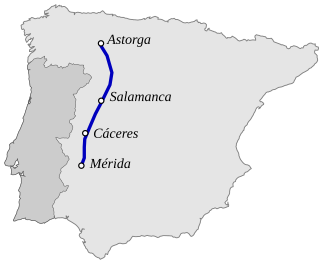
Flavia Julia Constantia was the daughter of the Roman Emperor Constantius Chlorus and his second wife, Flavia Maximiana Theodora.

Francesco Tatti da Sansovino (1521–1586) was a versatile Italian scholar, humanist and man of letters, also known as a publisher.

The Vía de La Plata or Ruta de la Plata is an ancient commercial and pilgrimage path that crosses the west of Spain from north to south, connecting Mérida to Astorga. An extended form begins further south in Seville and reaches north to the Bay of Biscay at Gijón. The path is used by the modern A-66 and AP-66 freeways, as well as by the older N-630 national road.

The sporocarp of fungi is a multicellular structure on which spore-producing structures, such as basidia or asci, are borne. The fruitbody is part of the sexual phase of a fungal life cycle, while the rest of the life cycle is characterized by vegetative mycelial growth and asexual spore production.

Beniamino Cesi was a celebrated Italian concert pianist and teaching professor of piano, who taught many of the most distinguished early 20th century pianists of the Neapolitan school, so that his influence spread very widely.

The Hymenochaetaceae are a family of fungi in the order Hymenochaetales. The family contains several species that are implicated in many diseases of broad-leaved and coniferous trees, causing heart rot, canker and root diseases, and also esca disease of grapevines. According to a standard reference text, the family contains 27 genera and 487 species.

Phellinus is a genus of fungi in the family Hymenochaetaceae. Many species cause white rot. Fruit bodies, which are found growing on wood, are resupinate, sessile, and perennial. The flesh is tough and woody or cork-like, and brown in color. Clamp connections are absent, and the skeletal hyphae are yellowish-brown.

Nobilissimus, in Byzantine Greek nōbelissimos, was one of the highest imperial titles in the late Roman and Byzantine empires. The feminine form of the title was nobilissima.

Istrian stone, pietra d'Istria, the characteristic group of building stones in the architecture of Venice, Istria and Dalmatia, is a dense type of impermeable limestones that was quarried in Istria, nowadays Croatia; between Portorož and Pula. Limestone is a biogenetic stone composed of calcium carbonate from the tests and shells of marine creatures laid down over eons. Istrian stone approaches the compressive strength and density of marble, which is metamorphosed limestone. It is often loosely referred to as "marble", which is not strictly correct.
Nobilissima visione is a 50-minute ballet in six scenes by Paul Hindemith, originally choreographed by Léonide Massine for the Ballet Russe de Monte Carlo. The libretto by Hindemith and Massine depicts episodes from the life of Saint Francis of Assisi. The work was completed in February 1938 and premiered at Theatre Royal, Drury Lane in London on 21 July 1938, with sets and costumes by Pavel Tchelitchew and under the baton of the composer. He led one performance of the new ballet at the Metropolitan Opera House in New York on 14 October of the same year.
DenisHenrion, was a French mathematician born at the end of the 16th century in France. He co-edited the works of Viète. He died around 1632 in Paris.
The terms Nobilissimus(most noble) and nobilissima familia(most noble family) have been used since the 11th century for the King of Hungary and his family. But it were then only a few that were mentioned in documents as such:

Kunigunde of Altdorf was a member of the Swabian line of the Elder House of Welf. She was also the ancestress of the younger House of Guelph, a cadet branch of the House of Este.

Teatro Bellini is a private theatre and opera located in the centre of Naples, across the street from the Academy of Fine Arts of Naples on Via Conte di Ruvo.
Luigi Rodriguez, also called Luigi Roderico was a Spanish-Italian painter, active in Naples, Italy.
Fomitiporia gabonensis is a fungus in the family Hymenochaetaceae. It was first isolated from Sub-Saharan Africa, specifically in the Guineo-Congolian forest. It has a pileate basidiome, small basidiospores and an absence of setae. Morphological features that differentiate this species with F. nobilissima and F. ivindoensis are its pileus' shape, pore surface color and diameter, as well as its ecology.
Fomitiporia ivindoensis is a fungus in the family Hymenochaetaceae. It was first isolated from Sub-Saharan Africa, specifically in the Guineo-Congolian forest. It has a pileate basidiome, small basidiospores and an absence of setae. Morphological features that differentiate this species with F. nobilissima and F. gabonensis are its pileus' shape, pore surface color and diameter, as well as its ecology.
F. polymorpha may refer to:

Corisca and the Satyr was painted in the 1630s by the Italian artist Artemisia Gentileschi. It currently hangs in a private collection.
Arianna in Nasso is an 1815 "azione drammatica", or scenic cantata in one act by Simon Mayr to a libretto by Giovanni Schmidt. It was premiered at the Teatro San Carlo, Naples, on 19 February 1815 with the role of Ariadne sung by Isabella Colbran who had requested Mayr to compose the piece for her to showcase her skills.











